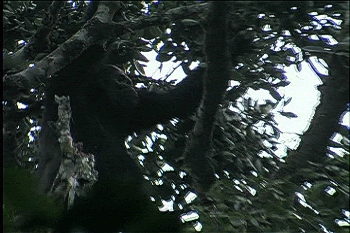The first ever professional footage of the world’s rarest gorilla, the Cross River gorilla ( Gorilla gorilla diehli), has been shot deep in the forested mountains of Cameroon. The only other existing footage of this Critically Endangered subspecies was taken from far away by a field researcher in 2005.
After weeks of effort, the Hamburg-based NDR Naturfilm was able to capture footage of a Cross River gorilla feeding on a fig tree some 30-40 feet above the ground in the Kagwene Gorilla Sanctuary, a park created just last year to protect a small group of this subspecies of the lowland gorilla.
“These gorillas are extremely wary of humans and are very difficult to photograph or film,” Dr. Roger Fotso, Director of the Wildlife Conservation Society’s (WCS) Cameroon Program, said in a press release. “Eventually, we identified and staked out some of the gorillas favorite fig trees, which is where we finally achieved our goal.”
 Still from film of Cross River gorilla. Photo © NDR Naturfilm. |
WCS, which is non-invasively monitoring the gorillas in the park, was instrumental in guiding the filmmakers to the animal.
“It’s unbelievable that one great ape subspecies has never been filmed for TV so far,” said Jörn Röver, Head of NDR Naturfilm. “We hope that our international production helps to raise awareness for these magnificent creatures and the work of the WCS.”
Hunting for bushmeat is the greatest threat to the Cross River gorilla. In addition, habitat loss for agriculture, roads, and pasture-land has diminished and fragmented the gorillas’ forests. It is estimated that only 250-300 Cross River gorillas survive.
“These extraordinary images are vital for the fight to save the world’s least known and rarest ape as well as the mountain rainforest on which they depend,” said Dr. James Deutsch, Director of the Wildlife Conservation Society’s Africa Program. “Over the past twenty years, local communities, the governments of Cameroon and Nigeria, funders, and committed conservationists have laid the foundation for a great conservation success story. We hope these pictures will introduce to the world the lead players in this story, the Cross River gorillas themselves.”
The footage by NDR Naturfilm can be seen here: http://www.wcs.org/multimedia/videos/cross-river-gorilla.aspx
Related articles
Cameroon moves to protect rarest gorilla
(11/26/2008) The government of Cameroon has created a national park to help protect the world’s most endangered great ape: the Cross River gorilla, reports the Wildlife Conservation Society (WCS), a group that provided scientific and technical support for the initiative.
Cameroon and Nigeria to protect world’s rarest gorilla
(09/05/2008) Cameroon and Nigeria have agreed to protect the the Cross River gorilla, world’s most endangered gorilla, reports the Wildlife Conservation Society, which helped broker the deal.
World’s rarest gorilla gets its own forest reserve
(04/18/2008) The government of Cameroon has established the first sanctuary exclusively for the world’s rarest type of ape: the Cross River gorilla, according to the Wildlife conservation Society (WCS), which helped support the project.
Rare gorillas use weapons to attack forest-intruding humans
(12/05/2007) Following the first documented cases of the Cross River gorillas — world’s most endangered gorilla — throwing sticks and clumps of grass when threatened by people, the Wildlife conservation Society (WCS) has announced new research to better protect the species from poaching and encroachment.
Time running out for world’s rarest gorilla
(06/21/2007) Time is running out for the world’s rarest subspecies of gorilla, the Cross River gorilla (Gorilla gorilla diehli) from the mountainous border region between Cameroon and Nigeria. With less than 300 individuals remaining, conservationists have drawn up a new plan to save the great ape from extinction.
Bushmeat from African apes sold in American markets
(07/06/2006) Bushmeat from wild primates in Africa is ending up on plates in North America and western Europe according to an article published in the current issue of New Scientist. Justin Brashares, a wildlife biologist at the University of California at Berkeley who carried out a survey of clandestine markets in seven major cities, says that the meat, which includes chimpanzee and gorilla parts, makes up nearly a third of the illegal international trade in bushmeat killed in Africa.
Gorillas use tools – photo documentation
(09/29/2005) For the first time ever, scientists have observed and photographed wild gorillas using tools, in one instance employing a stick to test the depth of a pool before wading into it, according to a study by the Bronx Zoo-based Wildlife conservation Society (WCS) and other organizations. Up to this point, all other species of great apes, including chimpanzees and orangutans, have been observed using tools in the wild, but never gorillas.